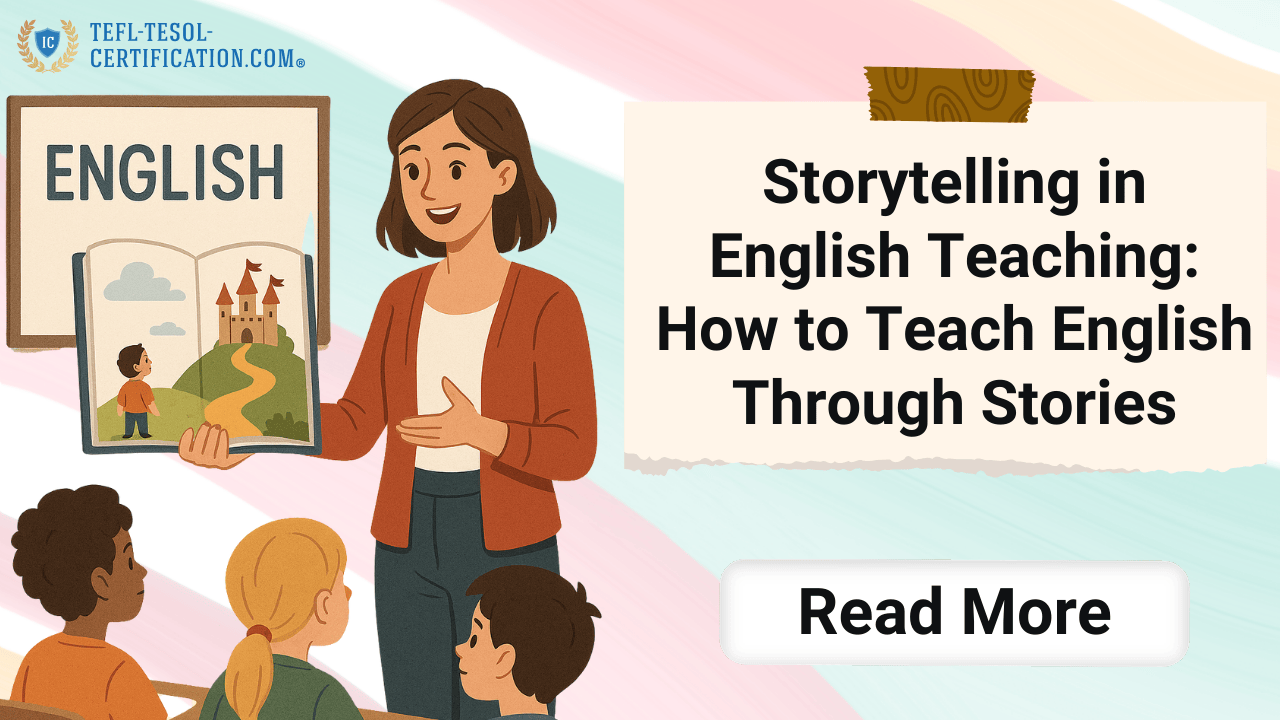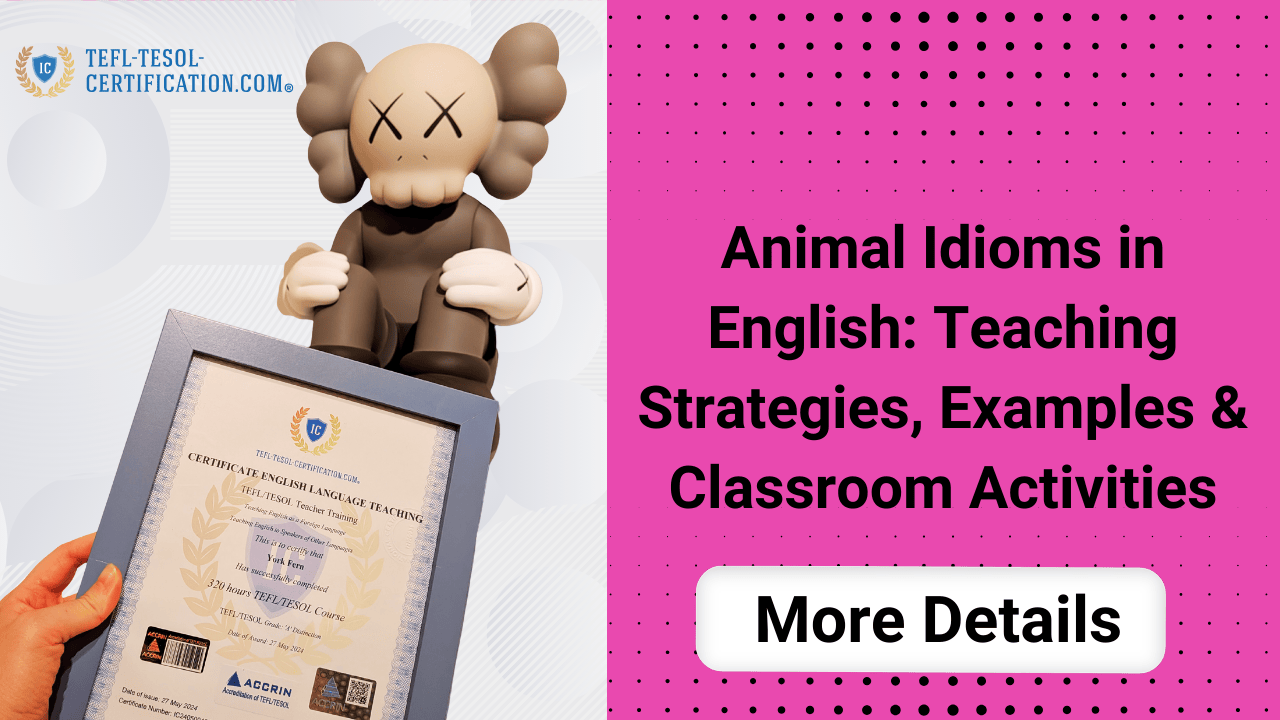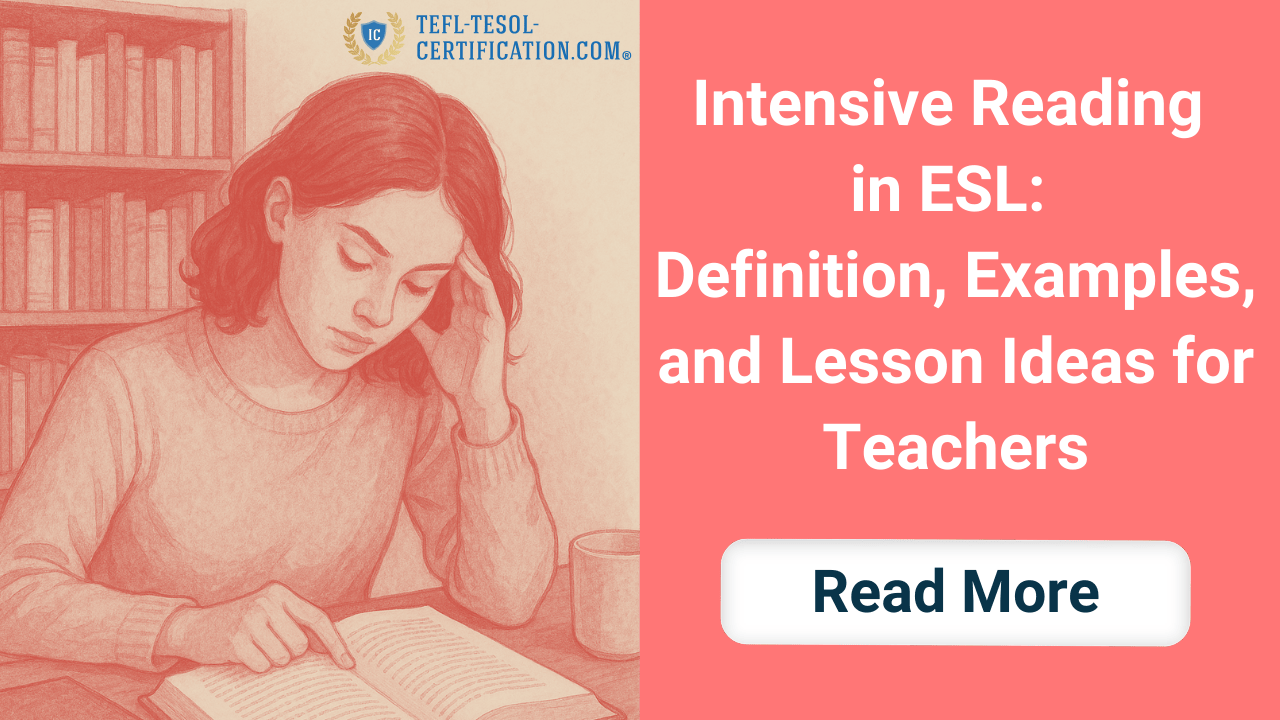And start earning money 💸 by teaching English in your own country, abroad, or online from anywhere on the planet! 🎁 Gifts and bonuses: professional support from your personal coach 🧑🏫 and job placement assistant 💼.

Storytelling in English Teaching: How to Teach English Through Stories
Table of contents
- Quick checklist: how to use storytelling in ELT lessons
- What storytelling in ELT is and why it works
- Storytelling methodology: structure, roles and scenarios
- Storytelling in English lessons: how to build it into your plan
- Teaching English through stories: how storytelling develops all four skills
- Sample stories for English lessons: 3 ready-made scenarios
- Low-stress assessment: giving feedback that helps
- Common storytelling mistakes in ELT and quick fixes
- Developing your own skills: TEFL, TESOL and storytelling
- My short story (and why I trust storytelling)
- 45–60 minute lesson plan: step-by-step scenario
- Adapting storytelling for levels A1–C1
- Story genres and tasks: quick teacher reference
- Storytelling and exams: IELTS, internal tests, job interviews
- Online storytelling lessons: keeping attention through the screen
- Materials that save prep time
- More story prompts for lessons
- Growing vocabulary organically, not by force
- Mini-FAQ from teachers
- Using CLIL and TBL to support storytelling
- Inclusive and safe story design
- Another real classroom story
- In short: small stories, big progress
Stories are one of the most natural ways humans learn. For centuries, people have passed on knowledge, values and experience through myths, fairy tales, family anecdotes and real-life case stories. When we hear a story, our imagination switches on, attention sharpens, emotions help us remember details — the brain “hooks onto” characters and events instead of isolated facts and grammar rules. That is why storytelling works so well in English lessons: learners follow the plot, empathise with the characters, predict what comes next, and almost without noticing, they read more, listen more, speak more and use new vocabulary more actively. In this kind of classroom atmosphere, English stops being a list of rules and becomes a tool for understanding and telling stories. In this article, we will look at how to use storytelling in English teaching and turn a standard lesson plan into a memorable, story-based learning experience.
Quick checklist: how to use storytelling in ELT lessons
- Clarify the lesson aim: vocabulary, grammar, skills (speaking / listening / reading / writing).
- Choose a story format: personal anecdote, real-life case, fairy tale, news item, or a short 6–8 sentence micro-story.
- Prepare support: key words, visuals, a simple timeline, character cards.
- Plan active phases: pre-story (warm-up), while-story (comprehension), post-story (reflection and production).
- Build in low-stress assessment: a simple checklist of criteria and formative feedback.
- Think about differentiation in advance: A2, B1, B2 get different tasks around the same story.
- Finish with reflection: “What new English did I use today because of this story?”
The checklist is there — but what exactly is storytelling in ELT, and why does teaching English through stories work so well, even with adult learners?
What storytelling in ELT is and why it works
In English Language Teaching, storytelling is not about telling “beautiful fairy tales” for entertainment. It is a flexible structure that connects the lesson goal and the language through emotion, images and action. A good story provides context, holds attention and activates memory. As a result, learners interact with English more naturally: they retell, summarise, argue, ask questions and share opinions.
The “I was there” effect
When learners can visualise a scene — the noise of a café, steam from a mug, a short pause before an important line — they find it easier to find the right words. They are not memorising sentences; they are living through them. Meaning generates language, not the other way round.
- For listening: a short audio clip with a clear character and a simple goal.
- For speaking: quick storyteller circles, 45–60 seconds per learner.
- For reading: a microtext of 120–180 words with visual and lexical support.
- For writing: “continue the story” in 6 sentences, using a few target linkers.
Where is the line between a story and an exercise?
A story has a goal and a conflict; an exercise is just a tool. If you notice that the lesson has become endless gap-fills and substitutions, go back to the conflict: what does the character want and what gets in the way? As soon as there is something at stake, even grammar like Past Simple vs Past Continuous suddenly becomes meaningful in real speech.
Storytelling methodology: structure, roles and scenarios
In my own classes, from beginners to intermediate and beyond, I keep returning to a simple structure: “Situation – Stakes – Twist – Outcome”. Below is a basic framework you can adapt freely to your age group, level and context.
Story template (A2–B2)
- Hook (1–2 sentences): a surprising fact or question.
- Setup: who is the main character, where are they, what do they want?
- Conflict: what gets in the way? Add one detail (a phone call, heavy rain, a deadline).
- Action: two steps the character takes towards the goal — including mistakes and corrections.
- Twist: a small change or surprise (an unexpected helper, a new condition).
- Outcome: the result plus a short reflection or “lesson learned”.
Classroom roles
- Facilitator (teacher): provides the framework and timing, keeps the storyline and the pace.
- Characters (students): bring the conflict to life, make decisions, try solutions.
- Observers: notice effective language, record useful vocabulary and expressions.
The “3–2–1” formula
Three supports (one picture, a small word list, a simple timeline), two roles (main character and partner), one twist. With this formula, even “quiet” groups start telling stories. After the first round it is very common to hear, “Can we do one more story?” — and that is a great sign of engagement.
| Level | Main goal | Story tools |
| A2 | Reduce speaking anxiety | Pictures, character cards, 45-second time limit |
| B1 | Develop argument and reasoning | Dilemmas, “if/then” situations, mini-debates |
| B2 | Accuracy and style | Genres: news, pitch, review; targeted vocabulary sets |
Storytelling in English lessons: how to build it into your plan
Before the lesson (pre-story)
- Choose a topic close to your learners’ real lives: work, travel, services, relationships, study.
- Prepare 8–12 key words and a few collocations connected to the topic (no more than that).
- Print or display 2–3 images that suggest possible scenes for the story.
During the lesson (while-story)
- Give a short “hook” and ask a simple choice question: “Will he go to the meeting or send an email instead?”
- Collect students’ ideas and build a shared timeline on the board.
- Act out a short scene as a mini-dialogue. For example:
💡 Unlock the secrets to doubling your teaching income with our exclusive checklist! 🎯 This checklist is designed for English teachers who want to 📈 attract more students and 🔥 keep them engaged for the long term.
After the lesson (post-story)
- Ask learners to write a continuation of the story in 6 sentences.
- Give a small checklist: linkers, verb tense, and 1–2 new phrases from the class “phrase bank”.
- Organise a gallery of stories: everyone reads at least one partner’s story and marks what they liked.
Teaching English through stories: how storytelling develops all four skills
Speaking
Story circles, “interview the character” tasks, and rotating partners every two minutes work especially well. Set a timer and let the room fill with voices. After a couple of rounds even quieter learners join in: they know the context and have ideas to contribute.
Listening
Short audio stories with built-in pauses for prediction. Ask: “What will he say next? Why?” Stop at a key point, elicit two or three ideas, then play the next part. Engagement is usually much higher than with standard comprehension-only tasks.
Reading
Microstories with gaps: 6–8 missing words or phrases. Learners work in pairs to fill the gaps, compare versions and discuss which choices make the story clearer and more convincing.
Writing
Story-based reviews and reflections instead of dry essays. For example, “I missed my flight because…” becomes a natural context to practise narrative tenses, sequencing and cause–effect connectors.
Sample stories for English lessons: 3 ready-made scenarios
A2 (younger learners): “The case of the missing breakfast”
- Hook: The kitchen is empty. On the table: crumbs and a small note saying “Sorry!”.
- Target language: breakfast, fridge, hungry, share, because, first/then.
- Tasks: build a timeline, ask five who/what/when/why questions, decide who the “breakfast thief” is and agree on rules for next time.
- Production: an apology note written from the character’s point of view (6 sentences).
B1 (teens): “The school start-up pitch”
- Hook: The school is giving a grant for the best student project.
- Target language: problem, solution, budget, feedback, risky, deadline.
- Tasks: assign roles (CEO, marketing, tech), prepare a 90-second pitch, answer three challenging questions from a “jury”.
- Production: a short social media post telling the story of a first failure and the next step.
B2 (adults / business): “The customer journey that changed everything”
- Hook: A late-night call: “Your order is delayed.”
- Target language: refund, apologise, workaround, escalate, loyal, expectation.
- Tasks: analyse a service failure, rebuild the chain of events, design a new service scenario.
- Production: an apology email plus a short report with lessons learned.
Low-stress assessment: giving feedback that helps
- Before the task: write criteria on the board: clarity, coherence, accuracy, expressiveness.
- During the task: observers note strong phrases, good questions and language for upgrade.
- After the task: use “feedback sandwiches”: what worked well – what to add or try next – a final positive comment.
A short reflection dialogue often works better than a long scoring rubric:
— What did you like about your partner’s story?
— It was clear and funny. I loved the twist.
— What will you try next time?
— I’ll add more linking words and slow down a bit.
Common storytelling mistakes in ELT and quick fixes
- Too much vocabulary. Aim for no more than 10–12 new items at once — the rest can come from context.
- Stories that are too long. A series of short scenes is more effective than one “novel-length” text.
- No real conflict. If nothing is at stake, there is little motivation to speak.
- Assessment that feels like an exam. Turn rubrics into a discussion of strong story moments and what made them work.
- Impersonal English. Encourage “I” and “we”: let learners speak from their own perspective.
Developing your own skills: TEFL, TESOL and storytelling
Many teachers notice that when they formally study lesson planning and methodology, it becomes much easier to integrate storytelling in a structured way. A solid TEFL or TESOL course can give you tools for choosing story types, building tasks around them and assessing students’ language through meaningful communication rather than isolated drills.
🚀 More students, 💰 higher income, 🌍 complete freedom! ✅ 112 verified platforms with top rates ⏳ Flexible schedule – work whenever and as much as you want 🎯 Simple requirements – start earning right away 💎 Boost your career and income by teaching students worldwide!
My short story (and why I trust storytelling)
One of my first storytelling lessons was in a small classroom with tired teenagers on a Friday evening. Two of them almost never spoke. I brought three pictures — an airport, a suitcase, heavy rain — and said: “We have ten minutes not to miss this character’s flight.” Within minutes, the room was full of voices. After fifteen minutes, the quietest student insisted on saying the final line of the story. Since then, I have used storytelling from A2 to B2 groups and see the same pattern: once there is a goal and an obstacle, language appears naturally.
45–60 minute lesson plan: step-by-step scenario
To make it easy to try storytelling tomorrow, here is a working lesson outline that suits both face-to-face classes and online lessons with breakout rooms and a shared board.
- 5 minutes – warm-up. One simple question plus one personal example from the teacher. For example: “When was the last time you laughed about a small everyday disaster?”
- 8 minutes – introducing the story. Show a picture, six key words and one main character. The group predicts what will happen next.
- 10 minutes – reading or listening. A micro-story of 150–180 words, or an audio clip up to 1:30, with pauses for prediction.
- 12 minutes – pair work. Retell the story from a different perspective (friend, colleague, customer), then add a small “What if…?” change.
- 7 minutes – production. A short written note, story-based post or 6–8 sentence voice message.
- 3 minutes – reflection. What worked well? How could one sentence be said more clearly or more naturally?
Notice that every stage is driven by action, not by long explanation. Grammar appears as a tool to solve the character’s problem, not as an isolated topic.
Adapting storytelling for levels A1–C1
A1–A2: safety and support
- Everyday topics: transport, shopping, food, friends, family.
- 3–5 key words plus gestures or pictures to support meaning.
- Basic structures: First – Then – Finally, and simple wh-questions.
- Main aim: reduce fear and start producing short, connected speech.
B1: movement and choice
- Stories built around dilemmas where the character must choose between options.
- Structures: Past Simple for events, Past Continuous for background.
- Technique: “three doors” — learners decide what happens if the character chooses each option.
B2–C1: precision and genre
- Genres: news story, customer review, business presentation, public talk.
- Strategies: adding concrete details, examples, light metaphor, polite disagreement.
- Main aim: precise formulations and appropriate style without losing spontaneity.
Story genres and tasks: quick teacher reference
| Genre | Communicative goal | Language focus |
| Personal story | Introduction, building rapport | Time expressions, emotion adjectives |
| Work-related case | Problem → solution | Phrasal verbs, cause–effect linkers |
| News story | Brief summary + opinion | Passive structures, modal verbs |
| Customer service story | Complaint → apology → agreement | Polite phrases and functional language |
| Instruction story | Explaining a process | Imperatives, sequencing expressions |
Storytelling and exams: IELTS, internal tests, job interviews
Stories fit naturally into many exam formats. In speaking exams, learners often get stuck in abstract language. As soon as they turn the topic into a story with a character and an event, answers become more coherent and engaging.
- Long-turn exam tasks: the cue card becomes a mini-story with a situation, goal and obstacle.
- School portfolios: instead of generic essays, collect short stories with reflections.
- Job interviews: practise “competency stories” using a simple structure like situation, task, action, result.
Online storytelling lessons: keeping attention through the screen
- Clear timing and frequent activity changes (every 8–10 minutes).
- Shared documents or boards to build timelines and phrase banks together.
- Breakout rooms for mini-scenes: two roles, one twist, four minutes, then switch partners.
- Short voice tasks between lessons: a one-minute story retelling or “story continuation”.
Materials that save prep time
- Character cards: name, goal, fear, a small speech habit or catchphrase.
- Story templates: “unexpected guest”, “package to the wrong address”, “secret helper”.
- Linking word lists: however, as a result, meanwhile, eventually, actually, in the end.
- Observer checklists: clarity, logic, accuracy, expressiveness.
More story prompts for lessons
A2 “Visitor from the future”
- Hook: At a bus stop, a person in strange clothes asks for directions.
- Tasks: practise questions, prepositions of place and polite requests.
- Production: an 8–10 line dialogue or a six-panel comic strip.
B1 “The broken alarm clock”
- Hook: The main character slept through an important interview.
- Tasks: rebuild the chain of events, invent an alternative ending, give time-management advice.
- Production: story-based “Do/Don’t” tips with real-life examples.
B2 “The email that saved the contract”
- Hook: A mistake in delivery puts a big project at risk.
- Tasks: agree on a compensation step, write an apology email with a solution and present a short process-improvement story to the “team”.
- Production: email plus an oral report: “what we will change in our process”.
Growing vocabulary organically, not by force
One simple principle for vocabulary in storytelling lessons: language appears when there is a need. Instead of 30 items on a list, give 10 and really work with them: hear them, say them, use them in a personal sentence, get feedback and reuse them in the next retelling. Useful techniques include:
- Class phrase bank. Learners add their favourite expressions to a shared poster or slide during story work.
- Mission-based retelling. Retell the story but add one new detail, emotion or twist.
- Word of the day. At the beginning of the next lesson, each learner uses one new word in a 20-second mini-story.
Mini-FAQ from teachers
“What if students don’t want to speak?”
Give them roles and clear time limits. “You’re the courier, you’re the client, you’re late, you have two minutes.” Roles turn speaking into a task, not a public performance.
“How many mistakes should I correct?”
During the story, correct only blocking errors that change the meaning. Save the rest for the post-story stage: write three or four common issues on the board and let students help correct them.
“How can I assess storytelling more objectively?”
Agree on criteria at the start: clarity, coherence, accuracy, expressiveness. Ask students to highlight “best moves” in their classmates’ stories. This is fair, motivating and builds awareness of what good communication looks like.
Using CLIL and TBL to support storytelling
You can easily combine storytelling with content-based and task-based approaches. With a CLIL-style angle, part of the story touches on geography, science or another subject area, and you teach the language needed to talk about it. With a task-based approach, the story creates a problem to solve; learners use English as a tool to complete the task, then reflect on the language they used.
Inclusive and safe story design
- Consider your learners’ backgrounds and avoid potentially sensitive topics; everyday scenarios usually work best.
- Offer degrees of challenge: light, medium and heavier twists, so groups can choose what feels right.
- Rotate roles: let quieter learners start as observers and gradually move into speaking roles.
Another real classroom story
An adult B1 group, Friday evening, 7:30 p.m. Tired faces, heavy bags, long work week. I say: “Tonight we’re going to save a client.” Twenty minutes later, they are discussing who will apologise, who will offer a discount and who will write the email. At the end, one learner says: “I came tired, but I’m leaving with a story I’ll tell my team tomorrow.” That is exactly why storytelling is worth the effort.
In short: small stories, big progress
Take the first simple step: choose a topic, add a conflict and give your learners a voice. Storytelling in English teaching is not about performing perfect narratives; it is about using meaningful, human stories to make vocabulary, grammar and skills stick. With a bit of structure and consistency, small classroom stories can create big changes in your students’ confidence — and in your own satisfaction as an English teacher.
Terms used:
EFL, ESL, TEFL, TESOL

York Fern
An English instructor with 12+ years of experience. I work for an online school and travel the world, teaching students from various countries, leveraging my TEFL/TESOL certification. Seeing the world's oceans, mountains, and cities with my own eyes has given me a profound appreciation for the importance of quality education and international communication.
and start earning by teaching English in your country, abroad, or online from anywhere in the world! Order the course with a 50% discount 💸 and receive as a gift the support of a personal coach 👨🏫 and job placement assistant! 🎁🚀 Hurry, limited spots available! 🏃♂️💨
💡 Unlock the secrets to doubling your teaching income with our exclusive checklist! 🎯 This checklist is designed for English teachers who want to 📈 attract more students and 🔥 keep them engaged for the long term.
🚀 More students, 💰 higher income, 🌍 complete freedom! ✅ 112 verified platforms with top rates ⏳ Flexible schedule – work whenever and as much as you want 🎯 Simple requirements – start earning right away 💎 Boost your career and income by teaching students worldwide!
choose us?



